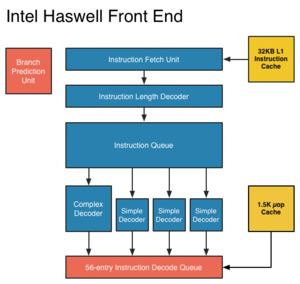Check out my first novel, midnight's simulacra!
Haswell: Difference between revisions
Jump to navigation
Jump to search
No edit summary |
No edit summary |
||
| Line 1: | Line 1: | ||
[[File:Haswellfrontend.png|right|thumb|Haswell frontend. Note the unified decode queue compared to the split queue of [[Ivy Bridge]]. ]] | [[File:Haswellfrontend.png|right|thumb|Haswell frontend. Note the unified decode queue compared to the SMT-split queue of [[Ivy Bridge]]. ]] | ||
Haswell follows [[Ivy Bridge]], the die-shrunk "[[Tick-Tock|Tock]]" of Intel's [[Nehalem]]. It will be manufactured on a 22nm process, and is scheduled to be released in Q1 2013. Haswell will feature [[transactional memory]], and represents a major step forward in power reduction, largely through new [[ACPI]] sleep states ("S0ix states") and improvements throughout the associated chipset ("Shark Bay"). | Haswell follows [[Ivy Bridge]], the die-shrunk "[[Tick-Tock|Tock]]" of Intel's [[Nehalem]]. It will be manufactured on a 22nm process, and is scheduled to be released in Q1 2013. Haswell will feature [[transactional memory]], and represents a major step forward in power reduction, largely through new [[ACPI]] sleep states ("S0ix states") and improvements throughout the associated chipset ("Shark Bay"). | ||
Revision as of 13:12, 1 December 2012

Haswell follows Ivy Bridge, the die-shrunk "Tock" of Intel's Nehalem. It will be manufactured on a 22nm process, and is scheduled to be released in Q1 2013. Haswell will feature transactional memory, and represents a major step forward in power reduction, largely through new ACPI sleep states ("S0ix states") and improvements throughout the associated chipset ("Shark Bay").
See Also
- "Intel's Haswell Architecture Analyzed: Building a New PC and a New Intel", Anandtech, 2012-10-05
- "Analysis of Transactional Memory in Haswell", Real World Technologies, 2012-02-15
- "Transactional Synchronization in Haswell", Intel SDN, 2012-02-07